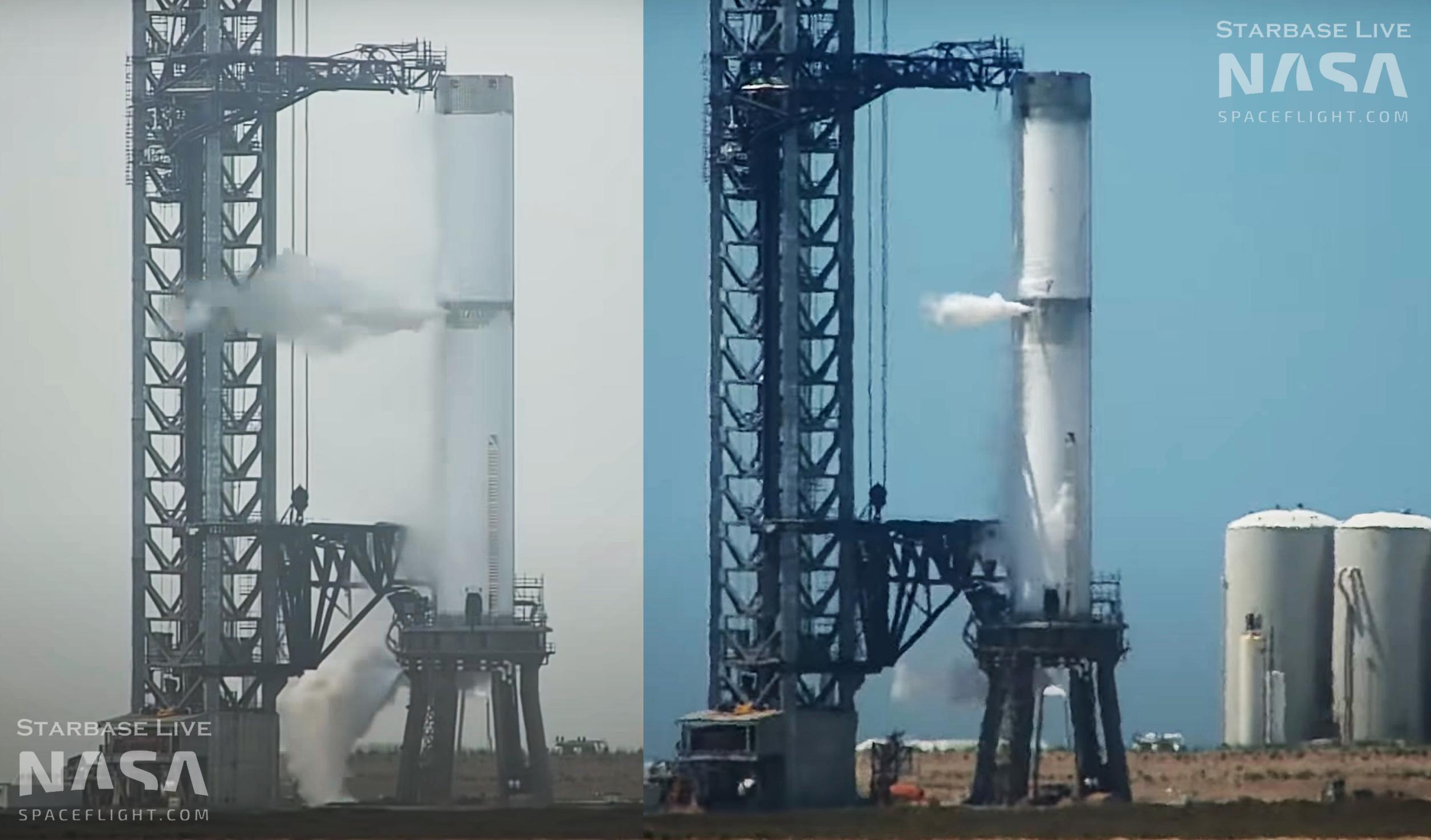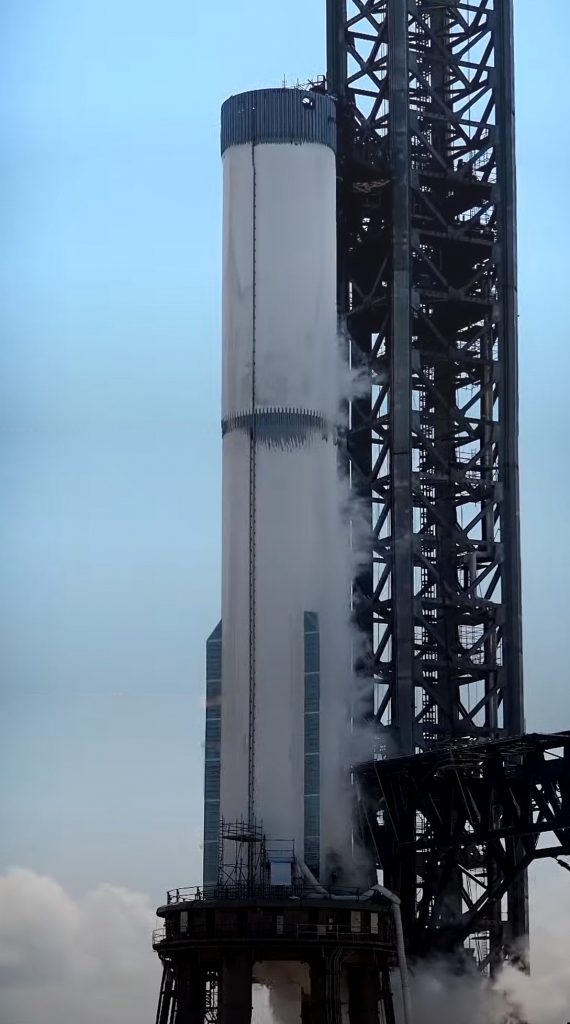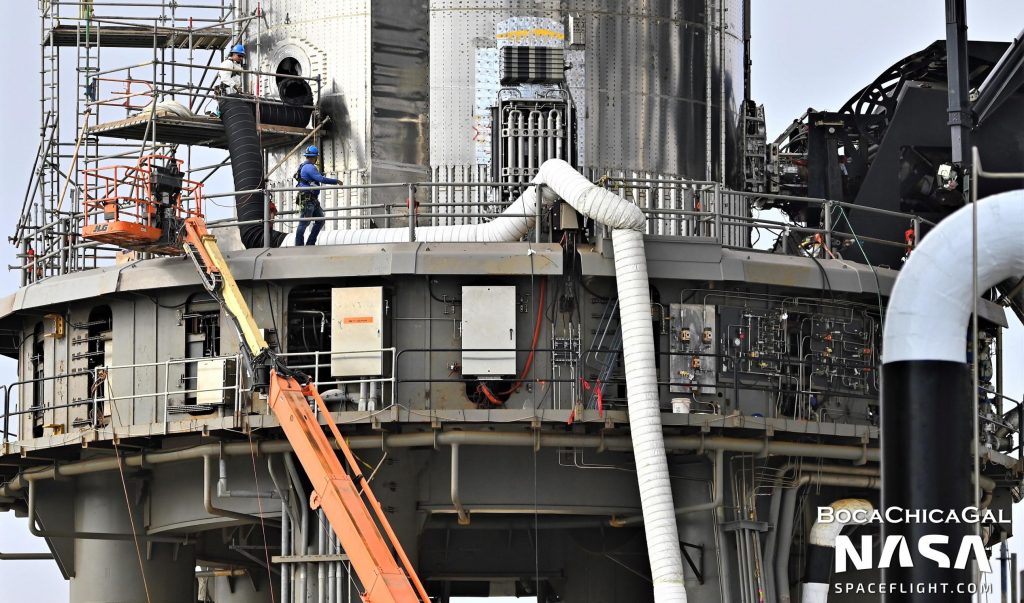

News
SpaceX’s repaired Starship booster survives back-to-back cryoproof tests
SpaceX’s upgraded Starship booster has completed a second and third cryogenic proof test in rapid succession after undergoing repairs to fix damage suffered during the first round of testing.
Testing began almost immediately after SpaceX rolled the repaired Super Heavy booster back to the orbital launch site (OLS) on May 6th. After a quick installation on the pad’s stool-like launch mount and another day of systems checks and integration, Booster 7 charged headfirst into its first post-repair cryoproof on May 9th.
Instead of cautiously feeling out the repaired plumbing and header tank over a series of small tests, SpaceX immediately performed a full cryogenic proof (cryoproof) and filled Booster 7 to the brim with about 3000 tons (~6.6M lb) of liquid nitrogen (LN2) or a combination of LN2 and liquid oxygen (LOx). Standing about 67 meters (~220 ft) tall and 9 meters (~30 ft) wide, it took about two hours to fully fill Super Heavy’s tanks with the equivalent of one and a half Olympic swimming pools of cryogenic liquid.
As always, that liquid (well below –320°F or –196°C) rapidly chilled the booster’s 4mm (~0.16″) thick steel tanks to cryogenic temperatures, which then froze moisture directly out of the humid Texas air, coating almost all of Super Heavy’s exterior with a layer of frost and ice.

SpaceX began detanking Booster 7 soon after the fill process was completed. Thanks to plenty of insulated plumbing and well-insulated ground storage tanks, SpaceX is able to recover nearly all of the LN2 and LOx used during cryoproof testing, which helps avoid the hundreds of semi-truck delivers that would otherwise be required to replenish the tank farm after even a single test.
As if to demonstrate that, SpaceX proceeded to put Booster 7 through a whole new cryogenic proof test just two days later, on May 11th. Once again, Super Heavy was fully loaded with thousands of tons of liquid nitrogen and oxygen. Unlike Cryoproof #2’s immediate detank, SpaceX – judging by the frost levels – kept Booster 7 topped off for a good hour before detanking.
In a last-minute surprise, after fully detanking B7 at the end of Cryoproof #3, SpaceX refilled the booster’s liquid oxygen tank with a few hundred tons of LN2 or LOx. Once the rocket’s thrust section reached some degree of thermodynamic equilibrium, SpaceX remotely retracted and reconnected the orbital launch mount’s Super Heavy umbilical. The launch mount umbilical or ‘quick disconnect’ is responsible for connecting Super Heavy to the pad’s gas supplies, propellant storage, power, and communications. The test SpaceX completed after Cryoproof #3 may have been a rough simulation of one scenario Starship could easily face: a post-ignition launch abort. In other words, if an orbital Starship launch was aborted just before liftoff but after quick-disconnect retraction, could it quickly reconnect to the booster with zero human intervention?
In a scenario where a QD failed to reattach to a fully-fueled Super Heavy after a launch abort, the odds of a catastrophic fire or explosion would immediately shoot up to near-certainty. In moderate quantities, simultaneously venting gaseous methane and oxygen from the same rocket is risky but manageable. Venting hundreds – let alone thousands – of tons while trapped on the ground would amount to creating a multi-hour fuel-air bomb just waiting for a spark. Multiple Starship prototypes (SN4, SN10) have already been destroyed in part by the flammability of methane gas.

Combined with the completion of two full cryogenic proof tests in less than two days, it appears that Super Heavy B7’s repairs were extremely successful. Had the first post-repair cryoproof not gone more or less perfectly, it’s hard to imagine that SpaceX would have attempted or completed an almost identical test two days later. If the second cryoproof hadn’t been nearly perfect, it’s even harder to imagine that SpaceX would have accepted the risk involved in detaching Booster 7’s umbilical during the same test window.
On May 12th, SpaceX’s main pad crane attached a lift jig to Super Heavy B7, implying that it will likely be removed from the orbital launch mount in the near future. If the repaired booster aced its tests, SpaceX’s next step would likely be Raptor engine installation and the start of static fire testing. It’s unclear if SpaceX wants to install all 33 engines at once or begin with a small handful. It’s also unclear if SpaceX will return Booster 7 to Starbase’s production facilities to finish Raptor, heat shield, grid fin, and aerocover installation.
Elon Musk
Tesla begins expanding Robotaxi access: here’s how you can ride
You can ride in a Tesla Robotaxi by heading to its website and filling out the interest form. The company is hand-picking some of those who have done this to gain access to the fleet.

Tesla has begun expanding Robotaxi access beyond the initial small group it offered rides to in late June, as it launched the driverless platform in Austin, Texas.
The small group of people enjoying the Robotaxi ride-hailing service is now growing, as several Austin-area residents are receiving invitations to test out the platform for themselves.
The first rides took place on June 22, and despite a very small number of very manageable and expected hiccups, Tesla Robotaxi was widely successful with its launch.
Tesla Robotaxi riders tout ‘smooth’ experience in first reviews of driverless service launch
However, Tesla is expanding the availability of the ride-hailing service to those living in Austin and its surrounding areas, hoping to gather more data and provide access to those who will utilize it on a daily basis.
Many of the people Tesla initially invited, including us, are not local to the Austin area.
There are a handful of people who are, but Tesla was evidently looking for more stable data collection, as many of those early invitees headed back to where they live.
The first handful of invitations in the second round of the Robotaxi platform’s Early Access Program are heading out to Austin locals:
I just got a @robotaxi invite! Super excited to go try the service out! pic.twitter.com/n9mN35KKFU
— Ethan McKanna (@ethanmckanna) July 1, 2025
Tesla likely saw an influx of data during the first week, as many traveled far and wide to say they were among the first to test the Robotaxi platform.
Now that the first week and a half of testing is over, Tesla is expanding invites to others. Many of those who have been chosen to gain access to the Robotaxi app and the ride-hailing service state that they simply filled out the interest form on the Robotaxi page of Tesla’s website.
That’s the easiest way you will also gain access, so be sure to fill out that form if you have any interest in riding in Robotaxi.
Tesla will continue to utilize data accumulated from these rides to enable more progress, and eventually, it will lead to even more people being able to hail rides from the driverless platform.
With more success, Tesla will start to phase out some of the Safety Monitors and Supervisors it is using to ensure things run smoothly. CEO Elon Musk said Tesla could start increasing the number of Robotaxis to monitors within the next couple of months.
Elon Musk
Tesla analyst issues stern warning to investors: forget Trump-Musk feud

A Tesla analyst today said that investors should not lose sight of what is truly important in the grand scheme of being a shareholder, and that any near-term drama between CEO Elon Musk and U.S. President Donald Trump should not outshine the progress made by the company.
Gene Munster of Deepwater Management said that Tesla’s progress in autonomy is a much larger influence and a significantly bigger part of the company’s story than any disagreement between political policies.
Munster appeared on CNBC‘s “Closing Bell” yesterday to reiterate this point:
“One thing that is critical for Tesla investors to remember is that what’s going on with the business, with autonomy, the progress that they’re making, albeit early, is much bigger than any feud that is going to happen week-to-week between the President and Elon. So, I understand the reaction, but ultimately, I think that cooler heads will prevail. If they don’t, autonomy is still coming, one way or the other.”
BREAKING: GENE MUNSTER SAYS — $TSLA AUTONOMY IS “MUCH BIGGER” THAN ANY FEUD 👀
He says robotaxis are coming regardless ! pic.twitter.com/ytpPcwUTFy
— TheSonOfWalkley (@TheSonOfWalkley) July 2, 2025
This is a point that other analysts like Dan Ives of Wedbush and Cathie Wood of ARK Invest also made yesterday.
On two occasions over the past month, Musk and President Trump have gotten involved in a very public disagreement over the “Big Beautiful Bill,” which officially passed through the Senate yesterday and is making its way to the House of Representatives.
Musk is upset with the spending in the bill, while President Trump continues to reiterate that the Tesla CEO is only frustrated with the removal of an “EV mandate,” which does not exist federally, nor is it something Musk has expressed any frustration with.
In fact, Musk has pushed back against keeping federal subsidies for EVs, as long as gas and oil subsidies are also removed.
Nevertheless, Ives and Wood both said yesterday that they believe the political hardship between Musk and President Trump will pass because both realize the world is a better place with them on the same team.
Munster’s perspective is that, even though Musk’s feud with President Trump could apply near-term pressure to the stock, the company’s progress in autonomy is an indication that, in the long term, Tesla is set up to succeed.
Tesla launched its Robotaxi platform in Austin on June 22 and is expanding access to more members of the public. Austin residents are now reporting that they have been invited to join the program.
Elon Musk
Tesla surges following better-than-expected delivery report
Tesla saw some positive momentum during trading hours as it reported its deliveries for Q2.

Tesla (NASDAQ: TSLA) surged over four percent on Wednesday morning after the company reported better-than-expected deliveries. It was nearly right on consensus estimations, as Wall Street predicted the company would deliver 385,000 cars in Q2.
Tesla reported that it delivered 384,122 vehicles in Q2. Many, including those inside the Tesla community, were anticipating deliveries in the 340,000 to 360,000 range, while Wall Street seemed to get it just right.
Tesla delivers 384,000 vehicles in Q2 2025, deploys 9.6 GWh in energy storage
Despite Tesla meeting consensus estimations, there were real concerns about what the company would report for Q2.
There were reportedly brief pauses in production at Gigafactory Texas during the quarter and the ramp of the new Model Y configuration across the globe were expected to provide headwinds for the EV maker during the quarter.
At noon on the East Coast, Tesla shares were up about 4.5 percent.
It is expected that Tesla will likely equal the number of deliveries it completed in both of the past two years.
It has hovered at the 1.8 million mark since 2023, and it seems it is right on pace to match that once again. Early last year, Tesla said that annual growth would be “notably lower” than expected due to its development of a new vehicle platform, which will enable more affordable models to be offered to the public.
These cars are expected to be unveiled at some point this year, as Tesla said they were “on track” to be produced in the first half of the year. Tesla has yet to unveil these vehicle designs to the public.
Dan Ives of Wedbush said in a note to investors this morning that the company’s rebound in China in June reflects good things to come, especially given the Model Y and its ramp across the world.
He also said that Musk’s commitment to the company and return from politics played a major role in the company’s performance in Q2:
“If Musk continues to lead and remain in the driver’s seat, we believe Tesla is on a path to an accelerated growth path over the coming years with deliveries expected to ramp in the back-half of 2025 following the Model Y refresh cycle.”
Ives maintained his $500 price target and the ‘Outperform’ rating he held on the stock:
“Tesla’s future is in many ways the brightest it’s ever been in our view given autonomous, FSD, robotics, and many other technology innovations now on the horizon with 90% of the valuation being driven by autonomous and robotics over the coming years but Musk needs to focus on driving Tesla and not putting his political views first. We maintain our OUTPERFORM and $500 PT.”
Moving forward, investors will look to see some gradual growth over the next few quarters. At worst, Tesla should look to match 2023 and 2024 full-year delivery figures, which could be beaten if the automaker can offer those affordable models by the end of the year.
-

 Elon Musk2 days ago
Elon Musk2 days agoTesla investors will be shocked by Jim Cramer’s latest assessment
-

 News1 week ago
News1 week agoTesla Robotaxi’s biggest challenge seems to be this one thing
-

 Elon Musk2 weeks ago
Elon Musk2 weeks agoElon Musk slams Bloomberg’s shocking xAI cash burn claims
-

 News2 weeks ago
News2 weeks agoTexas lawmakers urge Tesla to delay Austin robotaxi launch to September
-

 Elon Musk1 week ago
Elon Musk1 week agoFirst Look at Tesla’s Robotaxi App: features, design, and more
-

 Elon Musk2 weeks ago
Elon Musk2 weeks agoTesla Robotaxis are becoming a common sight on Austin’s public roads
-

 Elon Musk2 weeks ago
Elon Musk2 weeks agoxAI’s Grok 3 partners with Oracle Cloud for corporate AI innovation
-

 Elon Musk2 weeks ago
Elon Musk2 weeks agoSpaceX President meets India Minister after Starlink approval

















